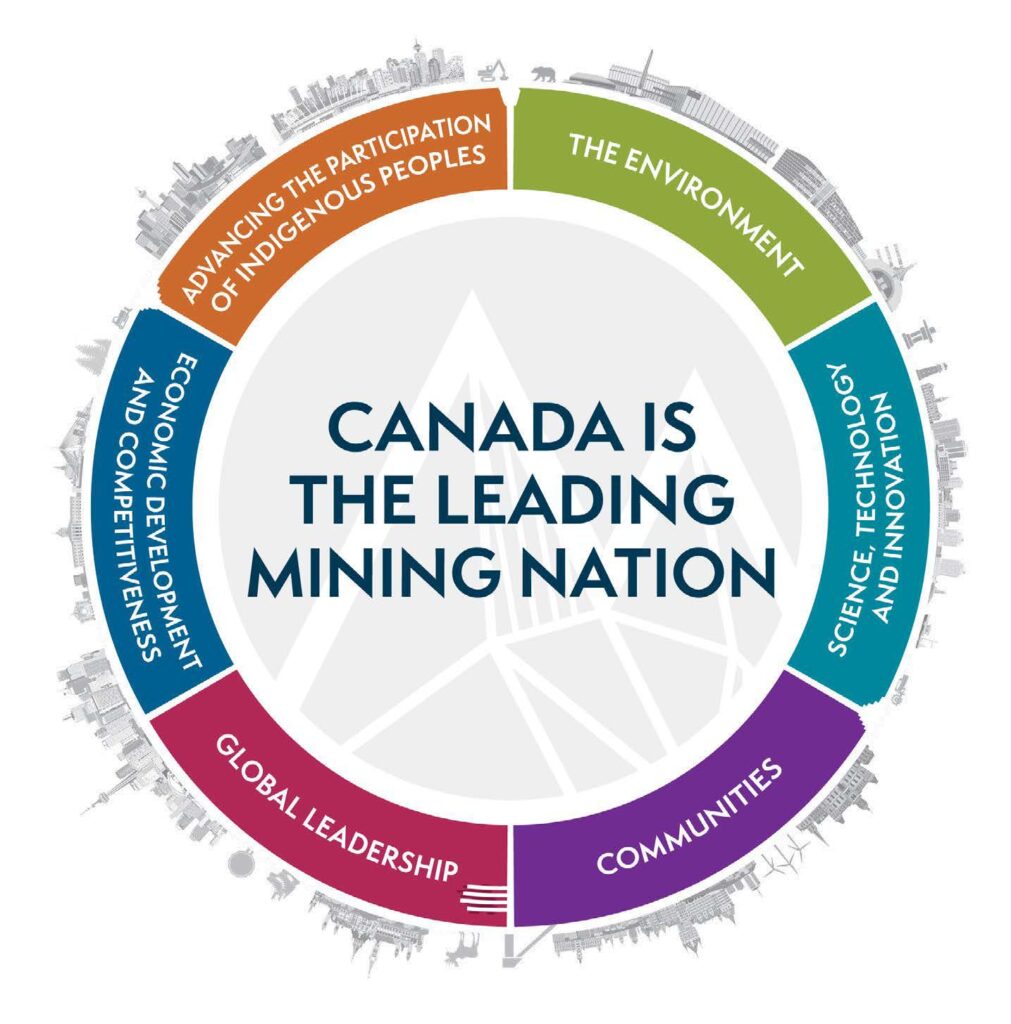Canada’s minerals and metals industry can seize the moment
Canada’s minerals and metals industry is poised to capitalize on the opportunities presented by global developments, such as the continued rise in the demand for a clean economy and more resilient supply chains. In June 2021, leaders of the G7 nations1 and the European Union (EU) committed to ending the pandemic and reinvigorating economies by “building back better.” This includes investing through an international partnership to narrow an infrastructure gap for developing nations by 2035—estimated at US$40 trillion. While specific details have yet to be released, a commitment of this scale undertaken by the United States (U.S.), Canada and other allies has great potential for Canada to increase exports of base metals, iron ore and other products needed for infrastructure development.
In April 2021, the Leaders Summit on Climate renewed international efforts to battle climate change. It included pledges from 44 countries, including Canada as well as the EU, which represent 70% of the world’s economy and global carbon emissions, to reduce emissions to net zero. Building on this commitment, in June 2021 Canada Minerals in Clean Energy Transitions, IEA, 2021.
Meeting these goals will require increasing deployment of clean energy technologies, which will supercharge demand for critical minerals.2 With its diverse, worldclass geological endowment, Canada holds many of the minerals needed to achieve net zero. And it has made significant progress with the U.S., the EU and other trading partners to be recognized as a safe, reliable and responsible supplier.
Major automakers have also made significant commitments to reduce their carbon footprint. General Motors set 2040 as a target to become carbon neutral, with 40% of its U.S. models offered as battery electric vehicles by the end of 2025. It will invest nearly US$800 million to convert a manufacturing plant in Ingersoll, Ontario, into Canada’s first largescale commercial electric vehicles (EVs) manufacturing plant. Ford Canada is investing $1.8 billion, including a combined investment of $590 million from the governments of Ontario and Canada, to upgrade its assembly plant in Oakville, Ontario, to start making EVs. Stellantis has committed to invest up to $1.5 billion to create its own EV platform in that province. In Quebec, Pallinghurst has invested over US$500 million for two key mining and processing projects that will aim to supply automotive and battery manufacturers, such as Tesla and Volkswagen in 2023. Lion Electric, a producer of heavy-duty electric vehicles, will construct a plant and innovation centre to produce battery modules and assemblies from lithium-ion cells. This investment of approximately $185 million includes commitments of $50 million each from the Governments of Canada and Quebec, and will enable Lion to electrify 14,000 vehicles each year.
Such commitments can go a long way in helping Canada establish domestic supply chains for critical minerals, batteries and EVs. These supply chains include activities such as exploration, and mining products including nickel, lithium, cobalt, copper and other minerals and metals which Canada produces or has the potential to produce in a sustainable manner. Supply chains also include downstream steps, such as refining and manufacturing, which can generate significant economic activity within Canada—as opposed to shipping raw materials to other countries where value is added.
Canada is well positioned to respond to increasing expectations by consumers and commitments made by trading partners to participate in supply chains that deliver responsibly produced goods.
The CMMP as a framework to guide recovery and growth
Canada’s minerals and metals industry managed well through a bruising pandemic, and the outlook for this sector is improving. But new challenges have emerged around inflation and rising interest rates, geopolitics, supply chain vulnerabilities, and the need to halt the pandemic in countries around the world.
The CMMP—released before the full effects of COVID-19 were realized—was designed to fortify Canada’s competitive position and to respond to challenges as they arise. It will continue to serve as a touchstone for the minerals and metals sector as Canada and the world shift toward recovery and growth, which are largely driven by increased demand and the transition to a clean, global economy.
Continued pan-Canadian collaboration, fostered through the CMMP, can help achieve net zero by 2050, rally stakeholders to capture opportunities for made-in-Canada supply chains for critical minerals and batteries, build capacity for processing, and support a more diversified workforce with the skills for a modern, low-footprint industry.
Continued collaboration will also be required to drive success in the CMMP’s Strategic Directions: Economic Development and Competitiveness; Advancing the Participation of Indigenous Peoples; the Environment; Science, Technology and Innovation; Communities; and Global Leadership.

Action Plan 2021, the second in a series, remains focused on implementing the CMMP objectives. It provides an update on the pan-Canadian initiatives introduced in Action Plan 2020, areas of collaboration identified in the Update to Action Plan 2020, and highlights the wealth of actions that federal, provincial and territorial (FPT) governments and stakeholders have taken to support Canadian mining. It also introduces an approach to help chart the course forward so that Canada’s mineral and metals sector can continue to grow prosperity across all regions of the country.
Realizing the vision
The vision Canada is the leading mining nation
Canada is home to a competitive, sustainable and responsible minerals industry that benefits all Canadians. The country is a global leader in mining-related science, technology, social and environmental practices with a clear and predictable regulatory environment, innovative clean technology solutions, and best management practices. It boasts a skilled and diverse workforce, an attractive investment climate, partnerships with Indigenous Peoples, and strong relations with communities.
This vision will be achieved through collaboration between federal, provincial, and territorial governments, Indigenous peoples, industry, advocacy groups and Canadians.
Principles to steer the vision
- The mineral development sequence provides essential products for the evolving global economy and substantial socio-economic benefits for regions across Canada, including northern, remote and isolated communities, and urban centres
- Responsible mineral development integrates the concept of sustainability—human, social, economic and environmental
- Canada’s bold vision for the industry is responsive and adaptable to emerging global forces and new frontiers
- Leading science, engineering and innovation advances the competitiveness of the minerals sector and fosters responsible industry practices
- A strong national brand and global leadership advances Canadian interests at home and abroad, strengthens the economies of Canada’s regions, and promotes Canadian values
- Respect for jurisdictional authority, effective legislative and regulatory frameworks, community engagement, and partnerships are foundational
Approach to achieve the vision
The Plan includes six strategic directions:
ECONOMIC DEVELOPMENT AND COMPETITIVENESS
Canada’s business and innovation environment for the minerals sector is the world’s most competitive and most attractive for investment.
ADVANCING THE PARTICIPATION OF INDIGENOUS PEOPLES
Increased economic opportunities for Indigenous Peoples and supporting the process of reconciliation.
THE ENVIRONMENT
The protection of Canada’s natural environment underpins a responsible, competitive industry. Canada is a leader in building public trust, developing tomorrow’s low-footprint mines and managing the legacy of past activities.
SCIENCE, TECHNOLOGY AND INNOVATION
A modern and innovative industry supported by world leading science and technology—across all phases of the mineral development cycle.
COMMUNITIES
Communities welcome sustainable mineral development activities for the benefits they deliver.
GLOBAL LEADERSHIP
A sharpened competitive edge and increased global leadership for Canada.











